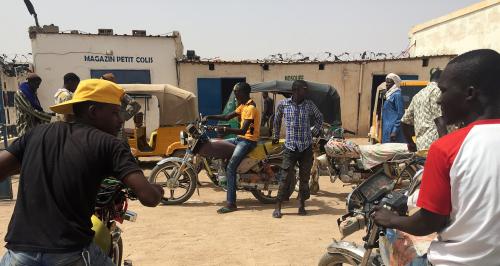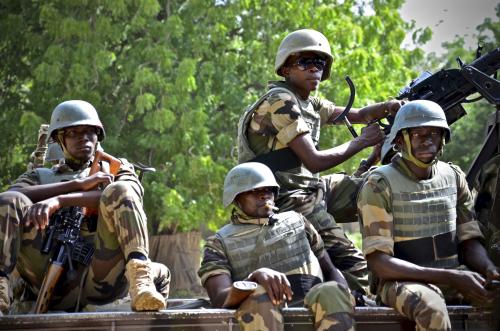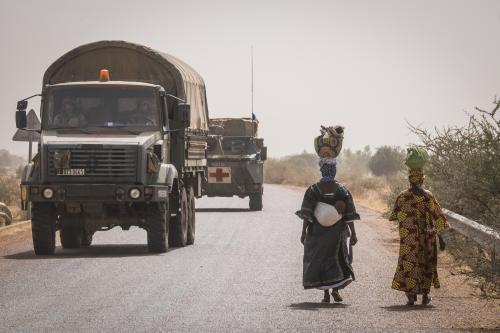In late May, the world rejoiced as 83 Nigerian schoolgirls—kidnapped, along with 194 others, by the vicious jihadist insurgency Boko Haram in Chibok in April 2014 to be sex and labor slaves—rejoined their families. During the May 2017 reunion, Western press showed images of happy, colorfully-clad family members rushing to embrace them. Nigeria’s ailing president Muhammadu Buhari popped in for a photo op before departing again for treatment in London for his undisclosed illness.
But in Nigeria, the media and public soon became preoccupied with another image and story: of one of the Chibok girls who remains in captivity, clad in black, touting a gun, and publicly embracing jihad, even if perhaps under severe duress. That contradiction in coverage reveals the profound challenges facing Nigeria, Niger, Cameroon, and Chad—the countries afflicted since 2009 with the now much weakened and splintered Boko Haram insurgency—in integrating victims, as well as former fighters and affiliates, back into society.
For years, the United Nations, individual countries, and experts have tried to perfect the disarmament, demobilization, and reintegration (DDR) of former fighters. Yet such processes are increasingly taking place while active insurgency, counterinsurgency, and counterterrorism operations remain in full swing—and in the context of religious radicalization, which challenges many established DDR practices. From Nigeria to Somalia, DDR now has to deal with defectors or those captured or liberated on the battlefield in the context of radicalization and in the absence of a peace agreement framework. Moreover, the “R” often becomes simple “reinsertion,” a far narrower concept than reintegration and a step that takes place before any formal disarmament and demobilization.
Below, I detail the Boko Haram-related DDR challenges I witnessed on a trip to Niger in May 2017, from who should be eligible for DDR and who should be punished or protected, to jobs and religious deradicalization. These same challenges are also acutely present in Nigeria, further magnified and complicated by ethnic tensions, other forms of conflict and criminality, the presence of anti-Boko Haram militias, and scale. Yet lessons from other countries, such as Somalia, are available, and I briefly sketch them and key elements of how a DDR effort in Niger and Nigeria should evolve.
Who’s in the Bush and in the Camp: Eligibility Criteria and Protection Standards
An international conference on DDR and deradicalization that I attended last month—which brought together local government officials, tribal chiefs, students, international experts, and NGO representatives in Diffa, Niger—revealed many of the “post-conflict” challenges that Niger, Nigeria, Chad, and Cameroon are all experiencing.
Diffa houses one of the DDR camps where several tens or perhaps hundreds of people who defected or escaped from Boko Haram are being held. The number is fuzzy, as there is little transparency regarding the admission and release process—a key deficiency of the DDR effort. Nor is there transparency or established criteria determining whether defectors, detainees, and escapees are sent to prison or to the DDR program. Many of Boko Haram’s captives were never radicalized, but merely enslaved; some may have committed heinous crimes under duress. It is crucial to establish a process that separates them (through a judicial process and perhaps imprisonment) from others who can be released after DDR or other assistance.
Without legal mechanisms or sorting criteria, the abuse of captured victims may be perpetuated or dangerous people may be released. These shortcomings disqualify Niger from much of U.N., U.S., and international assistance, since without clear, legal processes, Boko Haram members are still seen as terrorists (and legally, the United States can provide no material support).
U.N. DDR standards mandate that women and children be kept in separate facilities and provided special care. Yet in Diffa, women, often with young children, are kept at the same DDR facility as men. In Niger’s capital Niamey, a young boy who escaped from Boko Haram (after his village was raided and he was forced to carry supplies for Boko Haram for one day and then let go) has been languishing in prison for two years. Under U.N. rules, the Nigerien government should hand him over to UNICEF for support, education, and reintegration help. Yet instead of being seen as children, the young in war are often seen as vicious criminals.
More broadly, conditions at the Diffa DDR camp are reportedly difficult. I was not able to visit it myself (due to intense insecurity and government rules), but a prominent expert on Boko Haram told me of meager facilities consisting of three bare-bones buildings. Those kept at the camp complained of poor food, as well as insufficient water and shelter from the 115-degree heat. Many said that if they knew what was awaiting them, they would not have left the bush. In better circumstances—such as the U.N.-supported DDR facility in Baidoa, Somalia, which provides assistance to al-Shabab defectors and escapees, as well as those accused of supporting al-Shabab—the facilities can include computers, vocational training, and some recreational opportunities, in addition to better food, water, and shelter.
Mechanics and Imams: Jobs and Religious Re-education
Officials in Diffa point to competing priorities, in an area with chronic food insecurity and extreme poverty. And in fairness, the Nigerien government is paying far more attention to the issue of DDR than its counterpart in Nigeria, such as by organizing the Diffa conference. But the solutions and processes that Niger has proposed are often top-town decisions devised in the capital, imposed on local communities without adequate consultation and buy-in.
Take, for example, the always complex issue of how to provide jobs for those who complete the DDR process, and for former combatants more broadly. Without legal economic livelihoods, the risks are high that they resort to predatory criminality, illicit economies, or rejoin a militant group. In Niger, the government plans to train them as mechanics. But local community members are not keen on the idea, pointing out that motorcycles are prohibited in many of the villages to which the ex-Boko Haram “members” would be returning, and thus they would have no vehicles to repair. Yet as competition over land access is fierce, and Lake Chad is drying out rapidly, the government sees the mechanic route as easier than directing them back to farming or fishing.
Providing training and jobs to ex-insurgents comes with other risks. Sometimes local communities become resentful—after all, they hid from or fought against the insurgency, they did not join violent jihad, and they too are suffering unemployment and poverty, so they too should get support. And indeed, wide experience with DDR shows that if local communities also receive comparable assistance, they are more willing to accept ex-fighters back.
Finally, given the struggles with providing legal livelihoods and social opportunities, governments throughout Africa, including in Niger, are gravitating toward “religious re-education” as core to the DDR effort. Apart from the relative ease of hiring imams to deradicalize the ex-insurgents—compared to creating thousands of jobs—deradicalization also has ready funding streams. Western governments these days love to fund efforts to counter violent extremism, often shrunk to religious re-education in the field. And the focus on religious re-education also allows governments to put imams—however credible or not with the ex-insurgents—on their payroll and thus expand their patronage network and reinforce their political power.
The Elephant in the Room: DDR and Reconciliation in Nigeria
In addition to all the challenges that Niger is experiencing with DDR, Nigeria’s DDR and reconciliation processes, underdeveloped as they are, are far more complicated by the presence of anti-Boko Haram militias and by ethnic rifts.
For years, the Nigerian military left communities in the north exposed to Boko Haram’s brutal attacks, opening the space for these militias. At times, militias such as the Civilian Joint Task Force were the only protection local communities had, and they often proved to be fierce, if unpaid, fighters. But the militias have also engaged in severe human rights abuses, just like the Nigerian military. Now the militias do not want those labeled as Boko Haram back in their communities—regardless of what role they played—unless the government arms the militiamen with heavy weapons. It is urgent that the federal government of Nigeria and government affected by the Boko Haram insurgency start rapidly and systematically developing credible DDR processes. They will have to focus not just on Boko Haram members, but also the anti-Boko-Haram militias. Joint DDR camps should be carefully considered. With careful design, monitoring, and community support, such camps in Merca were among Somalia’s more effective DDR approaches.
Persisting Boko Haram suicide bombings and attacks in areas supposedly cleared of Boko Haram do not make communities any more disposed to accepting them back. Although Boko Haram fighters are now mostly hiding in the Sambisa forest and in the bush in Cameroon, they still terrorize vast areas of Nigeria enough to make Nigeria’s 2.2 million displaced fearful of returning to their former hometowns and villages. Meanwhile, those areas, as well as Nigeria’s Middle Belt, are experiencing a new wave of land theft, by criminals and by rival ethnic and religious groups and pastoralists and farmers who have been competing for decades. Thus, it is crucial that systematic DDR crucially focuses on the communities in the north and not just on the fighters and grapples with the further twist of generalized land theft and criminality in its design.
In Nigeria, the Boko Haram insurgency has heightened ethnic tensions, never too far beneath the surface in that country. True, most Boko Haram members have been Kanuri. A heavy-handed approach that paints all Kanuris, particularly Kanuri youth, as Boko Haram, only risks generating new alienation. A DDR effort there must be cognizant of the heightened ethnic tensions and explicitly include broader ethnic reconciliation.
And then there is scale. Thousands more joined Boko Haram in Nigeria than in Niger, and the area devastated by insurgency’s rampage and plunder is far greater. The DDR effort, if it eventually gets under way, as it should, will need to cover many more fighters, victims, and members of local communities. That will require a comprehensive, equitable, and clearly-specified system of eligibility, as well as large resources.
These are just some elements of what a comprehensive DDR effort in Nigeria and Niger needs to work through and what solutions it may contemplate. The complex DDR challenges are not easy to overcome in either Nigeria or Niger. But if Nigeria gets over its prideful insistence that Africa’s second largest economy does not need U.N. advice on DDR and if both it and Niger are willing to apply rule of law processes and standards to their nascent DDR and returnee efforts, they can make their problems more manageable. Then the “post”-Boko Haram moment will have a chance to evolve into an eventual peace, not merely another mutation of conflict.
The Brookings Institution is committed to quality, independence, and impact.
We are supported by a diverse array of funders. In line with our values and policies, each Brookings publication represents the sole views of its author(s).












Commentary
Under the hot Sahel sun: “Post”-Boko Haram challenges in Niger and Nigeria
June 8, 2017